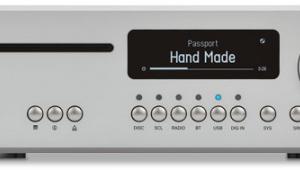Accustic Arts Drive Ii/tube Dac Ii (£6750/£6150)
Our tendency to attribute the revival in separate transports and DACs to the rise of MP3 players, DAB et al, didn’t anticipate Accustic Arts’ flagship models. Its Reference Series’ TUBE DAC II and DRIVE II offer neither USB nor mini-jacks to suggest the welcoming of lesser/newer digital sources. This pair is almost retro, recalling the earliest, most over-engineered high-end transports and DACs, with valves thrown in for good measure.
That they’re handsomely-styled, ergonomically intelligent exemplars of Teutonic build quality goes some way toward accounting for painfully high prices of £6150 for the DAC and £6750 for the transport. This places them in direct opposition to dCS, Esoteric and too many other acclaimed specialists to list. Suffice it to say, they have their work cut out for them.
A TWEAKER’S DELIGHT
Fortunately, the pairing is intrinsically tweakable, for two reasons. The first is that you have access to switchable polarity and mains filtering on the back of the transport, for the user’s experimentation without performing any irreversible mods. Audibility is down to one’s own or one’s system’s sensitivity to polarity inversion, and the condition of the mains. The second is a choice of S/PDIF (via 75ohm RCA phono and BNC) or balanced AES/EBU (via XLR) digital transmission, although my own findings are that the XLRs win hands down every time. But, again, this is a painless way to experiment and fine-tune one’s set-up.
Despite my preference for front-loaders, the 130x482x375mm, CD-Pro2LF-equipped DRIVE II is a pleasure to use because of the tactile reward of the sliding door. The magnetic puck snaps into place with ease, the front panel controls – rotaries rather than prosaic buttons – are easy-to-use and nicely weighted, and the display is perfectly clear. A well-made remote accompanies the DRIVE II.
The disc transport’s accompanying TUBE-DAC II, marginally shallower at 100x482x375mm, features a 12AX7/ECC83 valve output section, which made for an ideal comparison with my trusty Musical Fidelity kW/DM25 combination. Both were heard, along with Quad’s CDP99 II, through the McIntosh C2200/MC2102 pre/power combination feeding Wilson Sophias.
INTO THE STUDIO
Willy DeVille’s latest, Pistola is graced with a gorgeous track called ‘When I Get Home’, which opens with a lone, strummed guitar and harmonies almost on a par with Poco. Sparse and atmospheric, it showcased the Accustic Arts combination’s ‘signature’ virtue, a quality so admirable that it may be the system’s primary selling point: the recreation of space, allied to wonderful scale and openness. Although less transparent than this might suggest – I’m at a loss to explain how one can exist without the other – it ensures that the combination produces a huge, impressive, room-filling soundstage.
What does that have to do with a recording that’s virtually ‘unplugged’ and minimalist? Simple: it allows you to hear the much-vaunted ‘air’ alluded to by golden ear-types for decades: the sound of the studio, or the room, or the stage. The notion carries on to the next track, ‘Louise’, a light country ballad, which also possesses its own sonic environment.
Rather more ‘wall of sound’ is Nick Lowe’s ‘So It Goes’, sounding sensational on the recent best-of retrospective, Quiet Please. Superb transient attack is evident here, as well as rapid recovery: the refrain vocals appear in numerous locations, emerging out of nowhere and vanishing just as quickly, the Accustic Arts package never failing to locate each voice as precisely as Lowe must have positioned them when sitting at his mixing desk. The impression of power is better revealed by the pounding drums of ‘Heart of the City’, which never overwhelm Lowe’s primary instrument, the bass guitar.
A bit of grunge is always useful for testing a system’s ability to separate textures, and you don’t get further apart than the guitar salvoes which open Neil Young’s latest, Fork In The Road, and his distinctive vocals. No way around it: Neil’s voice is nasal and whiny and it could easily be engulfed by a guitar sound that harks back to his best work with Crazy Horse. The Accustic Arts combination represented both voice and guitar proportionately, contrasting the sounds perfectly to show how one supports the other. Although the Musical Fidelity components retrieved more detail, the DRIVE II and TUBE DAC II demonstrated top-to-bottom coherence on a par with the kW/DM25 in valve output mode.
As for which of the two is the standout product, should you be shopping for just a transport or a high-end DAC on its own, mixing and matching showed the DAC to contribute more to the overall character than the transport, but that’s consistent with nearly every two-box CD player package I’ve used. Because they’re so closely matched in character, the DAC exhibiting a touch of warmth to balance out the coolness of the DRIVE II, it’s clear they were designed for one another. To put it another way, there’s no imbalance whatsoever, their synergy working as well as the two sections of the kW/DM25 or even the elderly Marantz CD-12.
VERDICT
While the weak pound has upped the cost of this pair by at least 25% in the past year, even £9000 would be hard to justify: too many superior rivals sell for less. This Accustic Arts combination, though, sounds genuinely warm and convincing – ‘undigital’ as it were – while the build is exceptional, the ergonomics faultless and the listening experience highly pleasurable. Extremely good, rather than great.
Originally published in the July 2009 issue




















































